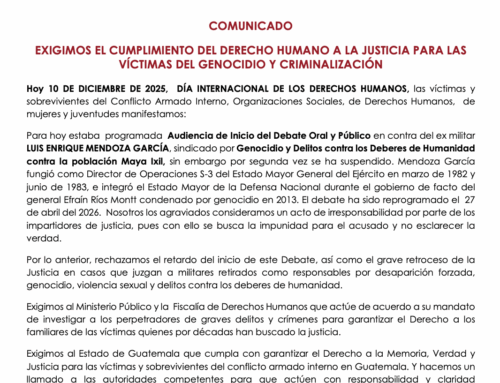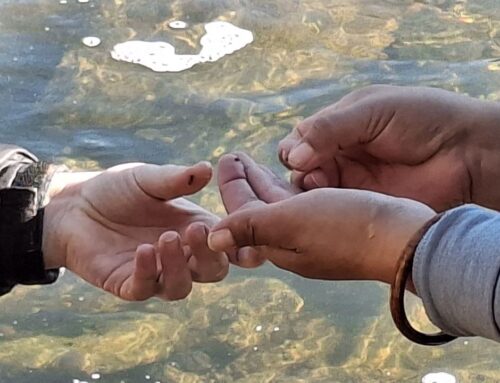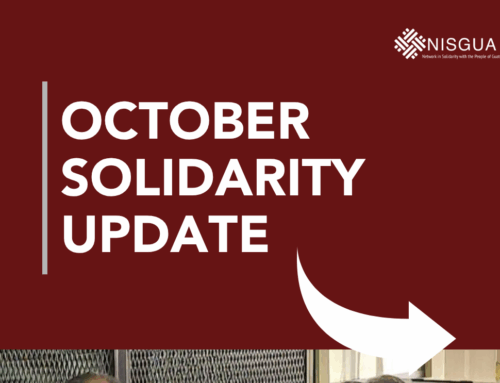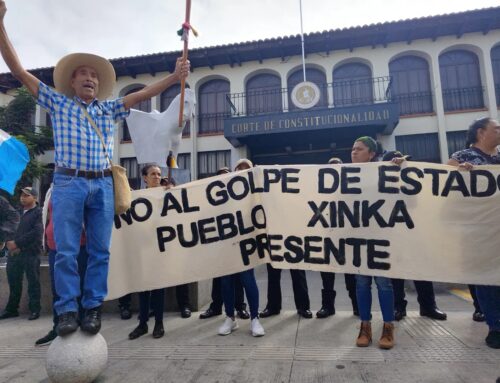In the lead-up to the “Guatemalan women healing towards justice: the case of Sepur Zarco,” NISGUA sat down with Maudi Tzay, a community psychologist with ECAP, to talk about the Sepur Zarco trial, community processes of healing, and the important work women survivors are doing as they seek justice for sexual violence. This translated interview has been edited for clarity. For the original extended version in Spanish, click here.
Maudi will join NISGUA on tour in the southwest and western United States from October 7 – 24. Visit our website for more information on ways to connect with the tour!
How did ECAP begin working in the region of Sepur Zarco? How did you start working on the issue of sexual violence?
ECAP began working in the Polochic region in 2001 around the issue of exhumations. There, the women survivors talked a lot about what happened in their communities. They talked a lot about the forced disappearance of their husbands. But the initiative to work on issues of sexual violence came about in 2003 when the women began to open up in a psychosocial support space about what happened to them [during the conflict].
Sexual violence is a silenced issue and there was still a lot of fear to talk about it. A lot of time passed before the women were able to come together as a group of victims. In this space, they began to work through what had happened to them and it was there that the issues of guilt and shame – and the guilt that the community had placed on them – began to arise. The women were scared to talk about the issue because of the labels they were assigned; many of them were referred to as “the soldiers’ women.” Since the women’s husbands were first disappeared, many people accused the women of having gone “looking for it” [sexual relations] with the soldiers. That’s the added plus with the crime of sexual violence – it burdens the women with guilt.
How did the methodology used in the psychosocial space come about?
We tried many different methodologies and some worked and others didn’t. We used art, which is more hands-on. The women painted murals and made sculptures, with the idea that as they were creating their art pieces, they talked about what had happened. Art is a really important methodology to use because you are creating things with your hands, using your imagination and creativity, but also, talking about a really serious and painful issue. The intention behind this was for the women to not feel [adversely] affected because of what they were talking about.
It became clear that this issue doesn’t only affect the victim, but instead, has impact at a national and international level. Other psychosocial processes began with community leaders, youth, other women who had experienced similar violence, and with people from other communities, all the while expanding the scope of the work. Sexual violence happens daily and is a continuum, which is why we carried out a process with other actors as well. When the women began to understand that it wasn’t their fault, they started to talk about justice.
At first, the idea wasn’t to take the case to court but to carry out a more symbolic process. There, emerged the idea of the Tribunal de Conciencia (Tribunal of Awareness) in 2010, where women – not only involved in the Sepur Zarco case but also women from Chimaltenango and Huehuetenango who also had other ongoing processes of justice and healing – began to talk about sexual violence and that it was necessary to prosecute it, symbolically. Afterwards, the women of Sepur Zarco decided they wanted to take their case to court. From there, the case began.
What about other organizations who were present?
The National Union of Guatemalan Women (UNAMG) has always provided support for the political training; this work helped the women know they had rights, helped them speak out, and participate in the processes.
UNAMG supported the political training while ECAP supported the psychosocial accompaniment. CONAVIGUA was present supporting the widows and working on the issue of the forced disappearances of the women’s husbands and seeking reparation. Each institution had its own specialization and they came together to form the Consortium Actors of Change. That consortium no longer exists but it led to the Alliance – made up of Women Transforming the World, UNAMG, and ECAP.
An emblematic image came out of the pre-trial evidentiary hearings – where a woman survivor would be testifying, accompanied by a psychologist on one side and a translator on the other. For you, what does this image represent?
I think it represents this Alliance – understood not only at the institutional level but one that very much includes the women survivors. When I see this image, I feel like it’s a big step for the women. They are sitting where they never thought they would be.
[It is also significant] that they are wearing shawls to cover their faces. It’s like they are being told that if you speak, something can happen to you. They are still not allowed to speak openly because repercussions can still happen. That is the reading I would give this picture. The women are there, together with the people who are accompanying them, speaking before a male judge; this also gives it another lens. It is a case of sexual violence and the fact that a man is listening to it is important for the case.
The women are not there alone; visible are the shoulders beside them that have been accompanying them for years. This wasn’t only a job that was carried out over two or three years, but instead, took place over more than ten. This is what this photograph shows.
What does the legal case mean in the healing process for the women?
The legal case has become a part of the healing process; clearly, a non-physical one, but part of healing in that it reinforces the idea that the women are not to blame. The verdict says to the women, “We believe you.” It was really important that the Tribunal began its verdict indicating that the piece of evidence that was most important in leading to a guilty verdict was the testimony of the women themselves.
Beyond the reparations, the fact that the accused have been convicted helps to heal and affirm the women’s [testimonies]. The women themselves said, “If they believe us, we will have shown that we are not lying and that there are guilty people.” This is what the sentence means for the women.
You talked about the fact that sexual violence is a universal theme. What is the importance of building cross-border solidarity in working to end sexual violence?
When you talk about conflicts and wars, the people who are most vulnerable will always be the women and children. The Sepur Zarco case sheds a lot of light on this issue. Who were the perpetrators? They are the authorities who, one would assume, are supposed to provide security to the population, but instead, it was the opposite. I think that as a civilian population, we believe that soldiers are there to protect the people and our country. But we realize that in many countries, the opposite occurs. When you talk about soldiers and militarized zones, there will always be the risk of sexual violence against women and children.
There were (and continue to be) other countries who have fundamental interests here in Guatemala and needed the State – represented by the government allied with the Army – to carry out their interests. That is what happened in the Polochic region, for example. The large landowners needed the Army so that they could maintain their properties and further dispossess people from their lands. Other countries, [like the United States], also play a role of always being on the side of the oppressor. If the oppressor had no means to oppress, they wouldn’t be an oppressor, right?
We see the same systems of sexual violence being repeated today. All of the human rights violations that are occurring are related and are historic. They continue to use the same strategies to fulfill the interests of the oligarchy, which includes the interests of other countries in, above all else, the land.
How can the work of the Alliance speak to other experiences and struggles against sexual violence?
Particularly in the case of sexual violence, all of the professional and accompaniment work that is carried out is done so for the following reasons: to not re-victimize the survivor and to guarantee their security and physical integrity; in the legal realm, so that laws exist that support the victim; and in the political realm, so that the women can understand that they are rights-bearers, that they can defend those rights, and that there is a need to. In the end, we see that all of the work that went into the Sepur Zarco case is transferable to other countries.
To be able to demand justice, first knowing what justice means for the victims is necessary. It isn’t only about attending to the victim, but also about preventing sexual violence so that it never happens again in any other country. That’s what the women exactly what the women are asking for – that in no other place in the world will women suffer what they have suffered. For this to happen, [the experiences gained in the Sepur Zarco case] need to cross borders.






Leave A Comment